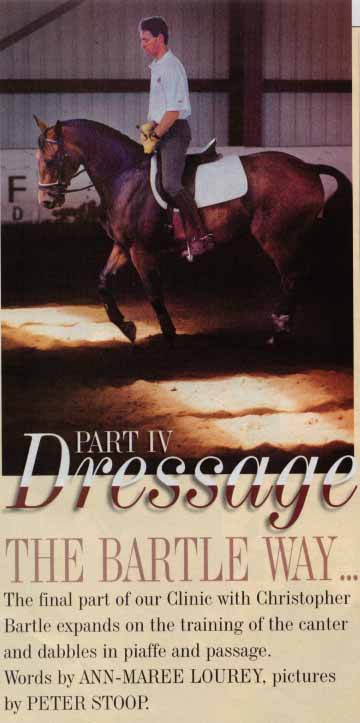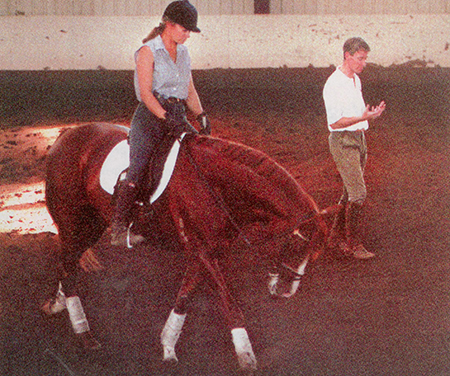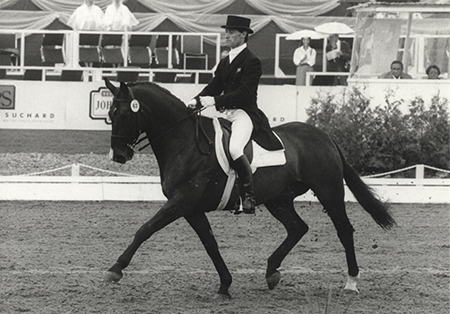One of the exercises the Christopher Bartle loves to see his pupils ride, and ride well, is the square.
“In this exercise you are riding a square instead of a circle, so again what you are doing is getting the horse to accept the half-halt down the outside rein,” he says.
“When riders ride through the corner in particular, and they are anxious to keep the horse out in the corner, and what they tend to do is use a lot of inside rein against the neck and a lot of inside leg trying to press the horse sideways into the corner.”
“My attitude is to say to the horse, in the case of an elementary horse you should be able to come through the corner on a quarter of a circle, equivalent to an 8 to 10 metres circle, so i will say to the horse with my outside rein as I approach that corner, ‘don’t turn yet, don’t turn yet’ until I get four metres from the corner and at that point I release the outside rein and say ‘now you can turn’ and then as soon as I come out of the corner I take them on the outside rein again, and say ‘now stay straight’”.
“So I set the target of where they turn and where they have to stay straight, and that’s all the issue is, just about trying to push them into the corner. If they ignore my outside rein, which they often do, then I say ‘stop, we’re not going to turn left, we’re going to the right’. They mustn’t make the assumption.”
“When you stop and turn, you always sit off the horse’s back a little bit as you approach a corner; partly you can then be able to say with that outside rein ‘don’t turn yet, don’t turn yet, don’t turn yet, then you get to the mark on the wall of the arena where you decide to turn and you do. It’s the penny in the slot thing, you do it till it works rather than holding on to it, until they start to recognize the signal. Even if you are in you trot and he is pulling away at you, you have to keep doing it and wait till it works.”
“Do it as often as you have to. Check that you have the timing right. No matter how good you are, you are sometimes going to get it wrong. The timing has to be as the outside shoulder comes back.”
On the subject of balance, Christopher has the ammunition ready to prevent the horse from taking over in the canter:
“Sometimes you see horses that are boring down, pulling, using their necks against the rider; usually because the riders started off by pulling against them,” he says.
“So you can imagine yourself on one side of the table and somebody else on the other, and you are each holding something, sharing it between you – and the person on the other side of the tables day ‘gimme’ and pulls it from you.”
“If you are not in a defensive position with your posture you will be pulled across the dining room table. That’s the picture you see very often with a horse that is pulling the rider over the withers. The rider is pulling back, and every time the rider pulls back the horse pulls back again, and gets them even further over the neck. I say to riders to think of the analogy of the dining room table so that they then work on it in order to prevent themselves being pulled forward. And they really can try it on a dining room table with a bit of rope and somebody on the other side.”
“To stop yourself from being pulled over the table you have to keep your pelvis thrust up against the table, and keep your elbows by your sides and stop your body from being pulled over the front. But once your arms get forward and your body gets a slight incline, you’ll get pulled.”
“A horse that is long in the back or working as if he is long in the back, your first priority is to get him up in the back. It’s like having a Landrover and a trailer; and they get unhitched and go away from each other – you need to keep them connected.”
“If the horse is pulling you out of the saddle, set your hips and don’t let them pull you across.”
“The same rules apply for the canter as the trot. Once the basic pace is established with the rider in control, it’s time to move into lateral work, without sacrificing of the quality that has been so hard-won.”
Always Christopher is emphasising a light seat.
“In canter half pass I say to the riders ‘don’t ride with your seat, you have to bounce across’. The horse comes across the arena as he is up in the air. He has to bounce up in the air and come down and up in the air and across. If you try to push the horse sideways with your seat you just flatten the canter.”
“I call it rolling pastry or making a pizza. You gradually flatten everything, when really you want to puff it up like a bouncy ball.”
“All the work in the canter is about puffing something up, it’s about taking your football and pumping air into it so it’s bouncier and springier, and the action of the seat, well, you sometimes see pushing with the seat and it flattens the movement, in trot or in canter. You can make the canter bigger and flatter like pizza. Or the more you bounce, the better they go. (He laughs.) I don’t really mean it. I don’t want people bouncing six feet in the air!”
“And in the half pass, if he is becoming strong, running away in the direction he is going, rattle the bit a little on the outside rein.”
And then there is the fascinating movement that challenges so many, the flying change. It’s a great opportunity for Christopher Bartle to do more on-foot skipping around the arena, demonstrating the rider positition in the changes, showing that his four steps to the perfect canter transition holds good for the changes, even in the ones.
“First of all you have to get the horse with an understanding that a change is wanted,” he explains. “That phase might take a different amount of time, depending on one horse to another. Some horses are naturals at flying changes, some don’t have a clue about it.”
“Those horses that don’t have a clue – you have to come across the arena, you can maybe set it up wiht half pass, you can come across the arena and at some point on the other side you say with your position that you are changing from canter right position to canter left position and that you want something to happen.”
“You might have to use a bit of whip or spur, but something has got to happen, the horse has got to learn that a change is expected.”
“During that phase, it doesn’t worry me that the horse is late behind. I want to keep the rhythm as best I can, but I realise that in smacking him I’ll probably get a bit of tension. Bit by bit as you do that, every time you come across the arena you are asking for a flying change and the horse will start to come across looking to do a flying change.”
“At that point your emphasis changes to working on the quality of canter. By that I mean that you work on the self-carriage, the energy in the step (I call it the bounce), the moment of suspension in the canter, the straightness of the canter, the relaxation of the poll, so that then you have a combination of the horse saying ‘I want to change’ combined with the rider trying to maintain the quality of the canter.”
“As the rider then changes the position of the hore and their own position from canter right to canter left position, the horse, within that bounce of the canter, will often then just offer the change.”
“The rider must keep the leg that was the outside leg and will be the new inside leg on, throughout the moment of asking for the change, that’s the critical thing.”
“At this point in the horse’s traiing there is no committed stride on which I say to the horse ‘now change’. I’m just working on the quality of the canter, changing position, trying to make it clear to them that I am now in a different canter position.”
“I’m now in canter left instead of canter right but I’m emphasising the quality of the canter and I’m waiting for the horse to work out ‘how do I change, how do I change?’ I don’t mind on which stride they do it, I just keep on working on it in the rhythm until they somehow click and do it.”
“The decision about when you start teaching the changes is sometimes governed by the level of test you are headed towards. It might be that you are running out of points, it might be governed by the fact that you want to make the horse better balanced and a better jumper in eventing, all sorts of reasons. You just get a hunch that this horse is ready to have a crack at a change.”
“I’m not very precise about when I start doing the changes but more and more I’m of the mind that I don’t want to get my horses going round forever and a day in counter canter, for so long that they lose any notion of doing a flying change. It makes it harder.”
Teaching pupils in the clinic, Christopher worked on cantering down the long side of the school, turning back to the wall on a half-circle, and making a flying change and then standing in the stirrups as the rider headed for the wall.
“You must not haul backwards and pull on the reins, you must grow taller, stand up,” he says. “Just as when you turn, you stand and turn, you must stand after the change. You don’t change until you can keep the bounce in the canter. If you can’t do it, come back to walk and stand up. You are trying to say to them ‘don’t change, don’t change.’ You show them that you are still clearly in left canter position, then clearly in canter right position.”
“Don’t lose the quality of the canter as you approach the change, don’t let it go long and flat, you need more energy in the step without hanging onto him.”
“You must be cantering towards your flying change chanting ‘spring in the step, spring in the step’ in the three beat rhythm and you must keep that in the flying change. In the stride before the change, take the half halt every second stride, then he will be soft in the stride of the flying change.”
“Sometimes the horse changes early behind. Be careful that the rider isn’t changing something in the moment of the change. You can have him lighter and in self-carriage in the change. You can give a little clearer aid, not so much of a prod with the outside spur, but more that you are giving a skip yourself.”
“I want to be able to change the lateral flexion without him anticipating the flying change, without him thinking to accelerate, without him thinking that he must change. Sometime they don’t come through as much in the change because they are still arguing in front.”
In the flying changes, keep; the outside leg on, the one that will be the new inside leg. You keep that leg on through the change and after the change. The shoulders are held over the leading leg, as if you are going to turn that way, even though you have changed to the other leg.”
“If the horse is slightly running away after the flying change, slightly stand, maybe even give a touch of the spur as you stand, although you have to weight up the spur because sometimes it will make him want to run away.”
“In the tempi changes, if he is being too strong, do a small set of tempis, walk while still on the diagonal and do a turn about the forehand in the opposite direction to the line you would usually take, to help the submission, then move into canter and begin again.”
“This will have some effect on the horse’s mental state. Don’t be too quick with your turn, thought, take your time about it. Say to the horse ‘walk, listen, relax, turn’”.
“On the diagonal all the time it’s like you are trying to ride a tightrope, doing your very best to keep him on that tightrope, locking your gaze like a laser beam on the letter at the end of the diagonal. Stare at it, stare at it.”
“In the one time changes, it’s the skipping action. All you do is skip on your horse and your horse skips along with you. And the less you move your leg, in a swinging sense, the better. It keeps the horse straighter, looks more elegant, and that I think has got to be the picture that you have in your mind as you’re going along skipping. The horse is dead straight, and as you skip, you hips go with the skipping.”
Christopher Bartle’s theories are very much non-stressful for the horse and the training of the higher level movements is no different.
The piaffe, for example, is another area where he insists that the horse learns ‘by accident’ when it has it right.
“In preparation for the piaffe, I do turns about the forehand one way and then the other,” he teaches.
“Stretch up into piaffe position yourself, and give a little double barrel if there isn’t enough energy. Keep your hands up, lighten your seat a little and wait for a diagonal step from the horse. Keep a loose hip, a loose thigh, keep him loose in the poll, try to simply keep collecting the walk. Piaffe doesn’t feel like passage, it doesn’t feel like trot, it feels like nothing.”
“In piaffe, we put ourselves in piaffe position, we excite them, and we get them through all the other training we’ve done, active in the hindleg, in other words, when we touch them we get the knee-jerk reaction.”
“In the turn around the forehand, I referred to the fact that they’ve already got certain programmed instinctive reflex responses anyway, or you hope they do, so in the piaffe, you rev them up, and you have those instinctive responses happening, so that the horse by accident, does a diagonal step.”
“You stop him, and pat him, and you do it again, and he says ‘oh I know what I can do to stop’ and so on. Then he does a few steps and he stop, and then you say ‘I didn’t say stop’ and you give him a kick, so he learns then that he has to keep going in piaffe until the rider says ‘okay, stop’.”
“That, to me, is the way to go about teaching the piaffe, and yet I see riders working the piaffe and somehow trying physically to make th ehorse piaffe – they take hold of it, they push with the seat, the kick, they smack, they do all sorts of things and again, if I were a horse, what would I do?”
The passage is taught, not surprisingly, from ‘the zone’.
“The time to use your leg is when you feel a lack of energy,” Christopher points out. “You try to pick up the passage as you do the trot, from walk, as the outside shoulder is coming forward.”
“Of course, you must have a reliable walk, first. Start in your mind first of all, thinking of the passage, in your mind start saying ‘now, now, now’, and don’t go for the big passage until you have got soft passage without tension. When you have a buzzy horse you have to have straightness, the correctness, the lack of tension before you ask for anything else.”
“Passage comes as you become gradually more demanding in the zone…. It’s the rising trot rhythm, every time the outside shoulder comes back, it’s ‘now’, half halt until they pick up a bit more lift in the step.”
“Use your whip to stir him, to excite him. If he is being sluggish, give him a little double barrel, get him to start thinking of energy.”
And as the clock ticked slowly around to the end of another long hot day’s teaching, Christopher packed up the left over water bottles in his eskies and headed off to catch a flight to Brisbane. No rest for the wicked – come 6.15 am next day he’d be in another arena with another dressage hungry group. And whether the riders there were up to playing with passage and piaffe or merely trying to fine tune a 20 metres circle, they were hardly likely to be disappointed.
We weren’t.



